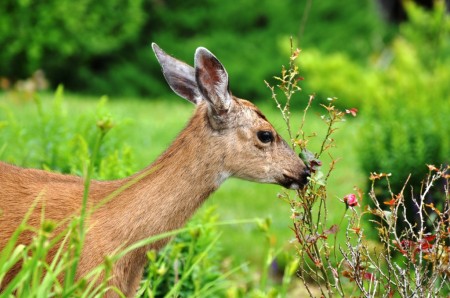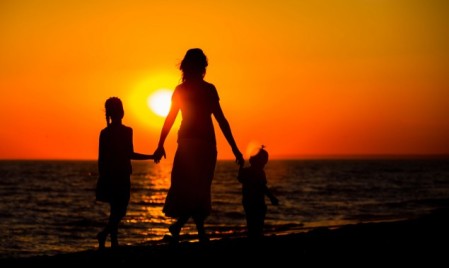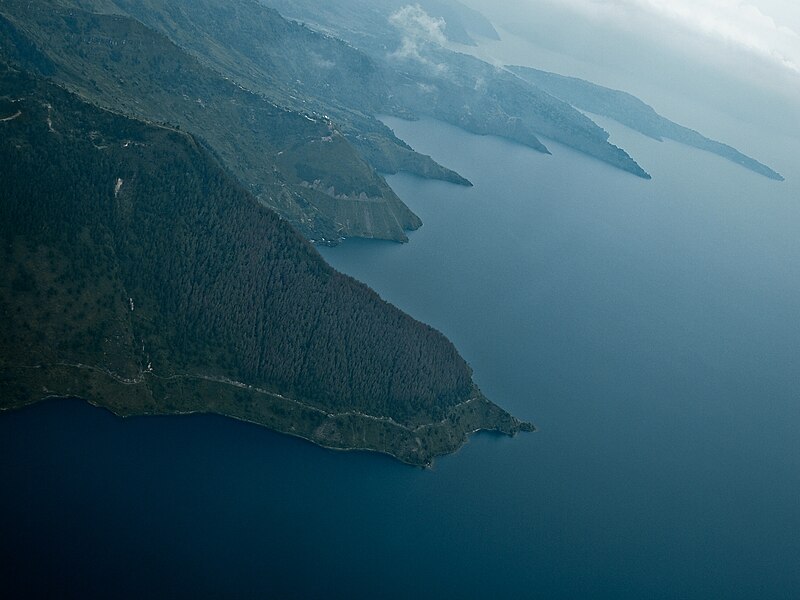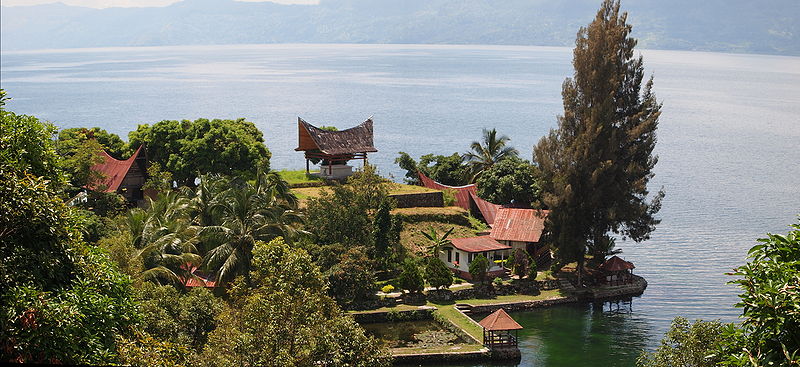Batak is a collective term used to identify a number of ethnic groups predominantly found in North
Sumatra,
Indonesia. The term is used to include the
Alas,
Kluet,
Singkil,
Karo,
Pakpak,
Simalungun,
Toba,
Angkola, and
Mandailing which are distinct but related groups with distinct, albeit related, languages and customs (adat).
In North Sumatra, Toba people typically assert their identity as
'Batak', while other 'Bataks' may explicitly reject that label,
preferring instead to identify as specifically 'Simalungun', 'Karo',
etc.
Prehistory
Linguistic and archeological evidence indicates that
Austronesian speakers first reached Sumatra from
Taiwan and the
Philippines through Borneo and/or Java about 2,500 years ago, and the Batak probably evolved from these settlers.
[3]
While the archaeology of southern Sumatra testifies the existence of
neolithic settlers, it seems that the northern part of Sumatra was
settled by agriculturalists at a considerably later stage.
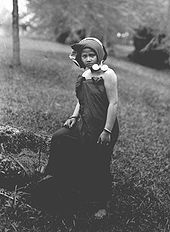
A Karo Batak woman in traditional clothes
Although the Batak are often considered to be isolated peoples,
largely because they were inland, away from influence by seafaring
European colonials, there is evidence that they have been involved with
trade and contact with other neighbouring kingdoms for a millennium or
more. Reliable historical records of the Batak before 1800 are almost
non-existent. The Bata were possibly documented in
Zhao Rugua's 13th-century
Description of the Barbarous People, which refers to a 'Ba-ta' dependency of
Srivijaya. The
Suma Oriental, of the 15th century, refers to the kingdom of Bata, bounded by
Pasai and the
Aru kingdom.
[2]
The Bataks were likely involved with trade with
Srivijaya for
benzoin and
camphor,
both of which were important commodities for trade with China, and grew
in the Batak lands of northwest Sumatra, perhaps from the 8th or 9th
centuries,
[2] and continuing for the next thousand years, Batak men carrying the products on their backs for sale at ports.
It is suggested
[citation needed] that the important port of
Barus in
Tapanuli was populated primarily by Batak people. A
Tamil
inscription has been found in Barus dated 1088, while contact with
Chinese and Tamil traders took place at Kota Cina, a trading town
located in what is now northern
Medan
that was established in the 11th century, and comprising 10,000 people
by the 12th century. Tamil remains have been found on key trade routes
to the Batak lands.
These trading opportunities may have caused migration of Batak from
Pakpak and Toba to the present-day Karo and Simalungun 'frontier' lands,
where they were exposed to greater influence from visiting Tamil
traders, while the migration of Batak to the Angkola-Mandailing lands
may have been prompted by 8th-century Srivijayan demand for camphor.
The
Karo marga or tribe Sembiring
"black one" is believed to originate from their ties with Tamil
traders, with specific Sembiring sub-marga, namely Brahmana, Colia,
Pandia, Depari, Meliala, Muham, Pelawi, and Tekan all of Indian origin.
Tamil influence on Karo religious practices are also noted, with the
pekualuh secondary cremation ritual specific to the Karo and Dairi
people.
From the 16th century onwards,
Aceh increased the production of
pepper,
an important export commodity, and in doing so needed to import rice,
which grew well on the Batak wetlands. Batak people in different areas
cultivated either
sawah "wet rice fields" or
ladang "dry
rice", and the Toba Batak, most expert in agriculture, would have
migrated to meet demand in new areas. The increasing importance of rice
had religious significance, increasing the power of the Batak high
priests, who had responsibility for ensuring agricultural success.
Language
Batak speak a variety of closely related languages, all members of the
Austronesian language family. There are two major branches, a northern branch comprising the
Pakpak-Dairi,
Alas-Kluet and
Karo
languages, which are similar to each, and a distinctly different
southern branch, comprising three mutually intelligible dialects:
Toba,
Angkola and
Mandailing.
Simalungun
is an early offspring of the southern branch. Some Simalungun dialects
can be understood by speakers of Batak Karo, whereas other dialects of
Simalungun can be understood by speakers of Toba. This is due to the
existence of a linguistic continuum that often blurs the lines between
the Batak dialects. Batak dialect still influences the dialects in
Medan city until now.
The Batak possess their own script known as the
Surat Batak.
[4]
The writing has chiefly ceremonial importance within traditional
religious ceremonies, and was subject to little change for this reason.
It is likely that the Batak people originally received their writing
system from southern Sumatra.
Society
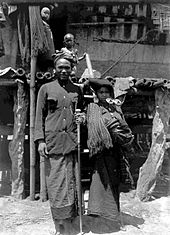
A Batak couple (1914–1919)
Batak societies are
patriarchally organized along clans known as
Marga. A traditional belief among the Toba Batak is that they originate from one ancestor "Si Raja Batak", with all
Margas descended from him. A family tree that defines the father-son relationship among Batak people is called
tarombo.
In contemporary Indonesia, Batak people have a strong focus on
education and a prominent position in the professions, particularly as
teachers, engineers, doctors and lawyers. Toba Batak are known
traditionally for their
weaving,
wood carving and especially ornate stone tombs.
Before they became subjects of the colonial
Dutch East Indies
government, the Batak had a reputation for being fierce warriors. Today
the Batak are mostly Christian with a Muslim minority. Presently the
largest Christian congregation in Indonesia is the
HKBP (
Huria Kristen Batak Protestan) Christian church. The dominant Christian
theology was brought by
Lutheran German missionaries in the 19th century, including the well-known missionary
Ludwig Ingwer Nommensen. Christianity was introduced to the Karo by
Dutch Calvinist missionaries and their largest church is the GBKP (
Gereja Batak Karo Protestan). The
Mandailing
and Angkola Batak were converted to Islam in the early 19th century. A
significant minority of Batak people do not adhere to either
Christianity or Islam, however, and follow traditional practices known
as the
agama si dekah, the old religion, which is also called
perbegu or
pemena.
Ritual cannibalism
Ritual cannibalism is well documented among Batak people, performed in order to strengthen the eater's
tendi.
[2] In particular, the blood, heart, palms and soles of the feet were seen as rich in
tendi.
In
Marco Polo’s
memoirs of his stay on the east coast of Sumatra (then called Java
Minor) from April to September 1292, he mentions an encounter with hill
folk whom he refers to as “man-eaters”.
[6]
From secondary sources, Marco Polo recorded stories of ritual
cannibalism among the "Battas". Marco Polo's stay was restricted to the
coastal areas, and he never ventured inland to directly verify such
claims. Despite never personally witnessing these events, he was
nonetheless willing to pass on descriptions which were provided to him,
in which a condemned man was eaten:
- "They suffocate him. And when he is dead they have him cooked, and
gather together all the dead man's kin, and eat him. And I assure you
they do suck the very bones till not a particle of marrow remains in
them...And so they eat him up stump and rump. And when they have thus
eaten him they collect his bones and put them in fine chests, and carry
them away, and place them in caverns among the mountains where no beast
nor other creature can get at them. And you must know also that if they
take prisoner a man of another country, and he cannot pay a ransom in
coin, they kill him and eat him straightway.[7]
The Venetian
Niccolò de' Conti (1395–1469) spent most of 1421 in Sumatra in the course of a long trading journey to
Southeast Asia
(1414–1439), and wrote a brief description of the inhabitants: "In a
part of the island called Batech live cannibals who wage continual war
on their neighbors.".
[8][9]

Judgement Place of Toba Batak
Sir Thomas
Stamford Raffles
in the 1820s studied the Batak and their rituals and laws regarding the
consumption of human flesh, writing in detail about the transgressions
that warranted such an act as well as their methods.
[10]
Raffles stated that "It is usual for the people to eat their parents
when too old to work," and that for certain crimes a criminal would be
eaten alive: “The flesh is eaten raw or grilled, with lime, salt and a
little rice.”.
[11]
The German physician and geographer
Franz Wilhelm Junghuhn visited the Batak lands in 1840-41. Junghuhn says about cannibalism among the Batak (whom he called "Battaer"):
- “People do the honest Battaer an injustice when it is said that they
sell human flesh in the markets, and that they slaughter their old
people as soon as they are unfit for work...They eat human flesh only in
wartime, when they are enraged, and in a few legal instances.”
Junghuhn tells how after a perilous and hungry flight he arrived in a
friendly village, and the food that was offered by his hosts was the
flesh of two prisoners who had been slaughtered the day before,
[12]
however he maintains that the Batak exaggerated their love of human
flesh in order to frighten off would-be invaders and to gain occasional
employment as
mercenaries for the coastal tribes who were plagued by
pirates .
[13]
Oscar von Kessel visited Silindung in the 1840s and in 1844 was
probably the first European to observe a Batak cannibalistic ritual in
which a convicted adulterer was eaten alive. Interestingly, his
description parallels that of Marsden in some important respects,
however von Kessel states that cannibalism was regarded by the Batak as a
judicial act and its application was restricted to very narrowly
defined infringements of the law including theft,
adultery,
spying or treason. Salt, red pepper and lemons had to be provided by
the relatives of the victim as a sign that they accepted the
verdict of the community and were not thinking of
revenge.
[14]
Ida Laura Pfeiffer visited the Batak in August 1852 and although she did not observe any cannibalism, she was told that:
- "Prisoners of war
are tied to a tree and beheaded at once; but the blood is carefully
preserved for drinking, and sometimes made into a kind of pudding with
boiled rice. The body is then distributed; the ears, the nose, and the
soles of the feet are the exclusive property of the Rajah,
who has besides a claim on other portions. The palms of the hands, the
soles of the feet, the flesh of the head, and the heart and liver, are
reckoned peculiar delicacies, and the flesh in general is roasted and
eaten with salt. The Regents
assured me, with a certain air of relish, that it was very good food,
and that they had not the least objection to eat it. The women are not
allowed to take part in these grand public dinners."[15]
Samuel Munson and Henry Lyman, American Baptist missionaries to the Batak, were cannibalized in 1834. Dutch and German
missionaries to the Batak in the late 19th century observed a few instances of cannibalism and wrote lurid descriptions to their home
parishes in order to raise donations for further missions.
[16] The growing Dutch influence in northern Sumatra led to increased
Malay influence in coastal trade and plantations, pushing the Karo farther inland. Growing ethnics tensions culminated in the
1872 Karo Rebellion
where the Karo were suppressed by Dutch and Malay forces. Despite this,
Karo resistance to Dutch imperialism lingered into the early 20th
century.
[17] In 1890 the Dutch colonial government banned cannibalism in the regions under their control.
[18]
Rumors of Batak cannibalism survived into the early 20th century but it
seems probable that the custom was rare after 1816, due partially to
the influence of
Islam.
[19]
Geography

The regencies of
North Sumatra,
coloured where they have a majority Batak population. The Karo lands
extent significantly to the north and east of the area coloured on the
map, almost to
Medan. Borders with the
Minang and
Acehnese are noted

Location ethnic groups of Sumatra, the Batak tribes located around Lake Toba in North Sumatra
The Batak lands consist of
North Sumatra province, excluding
Nias island and the historically Malay kingdoms of the East coast. In addition, part of the Karo lands extend into modern-day
East Aceh Regency in
Aceh province, while parts of the Mandailing lands lie in
Rokan Hulu Regency in
Riau. Significant numbers of Batak have migrated in recent years to prosperous neighbouring Riau province.
To the south of North Sumatra are the Muslim
Minangkabau of
West Sumatra, while to the north there are various Muslim Acehnese peoples.
Traditional Batak religion

Batak village on Samosir island
The various Batak cultures differ in their pre-colonial religious
ideas as they do in many other aspects of culture. Information about the
old religious ideas of the
Mandailing
and Angkola in southern Batakland is incomplete, and very little is
known about the religion of the Pakpak and Simalungun Batak. For the
Toba and Karo on the other hand the evidence in the writings of
missionaries and colonial administrators is relatively abundant.
Information on the traditional forms of Batak religion is derived mainly
from the writings of
German and Dutch missionaries who became increasingly concerned with Batak beliefs towards the end of the 19th century.
[20]
Various influences affected the Batak through their contact with Tamil and
Javanese traders and settlers in southern Batakland, and the east and west coast near Barus and
Tapanuli, in particular the large
Padang Lawas temple complex
in Tapanuli. These contacts took place many centuries ago and it is
impossible to reconstruct just how far the religious ideas of these
foreigners were adopted and reworked by the Batak. It is suggested that
the Bataks adopted aspects of these religions, specifically Mahayana
Buddhist,
Shaivist, and
Tantrist practices
[2] within their own customs.
[21]
The modern Indonesian state is founded on the principles of
pancasila,
which requires the belief in 'one and only God', the practice of either
Protestantism, Catholicism, Islam, Buddhism or Hinduism, one of which
must be entered on an individual's
KTP.
Traditional religions are not officially recognised, and accordingly
traditional religions are increasingly marginalised, although aspects of
the traditional Batak religion are still practised alongside
Christianity, and, to a lesser extent, Boop.
Creation myths
There are many different versions in circulation. These were formerly
passed down through oral tradition but have now been written down in
the local languages. There are also large collections of Batak tales
collected by European scholars since the mid-19th century and recorded
in European languages, mostly Dutch.
[22]
At the beginning of time there was only the sky with a great sea
beneath it. In the sky lived the gods and the sea was the home of a
mighty underworld
dragon Naga Padoha. The earth did not yet exist and human beings, too, were as yet unknown. All the surviving
myths record that at the beginning of creation stands the god
Mula Jadi Ba Moron.
His origin remains uncertain. A rough translation of the name is the
"beginning of becoming". The creation of everything that exists can be
traced back to him.
Mula Jadi lives in the upper world which is usually thought of as divided into seven levels. His three sons,
Batara Guru,
Mangalabulan and
Soripada were born from eggs laid by a hen fertilized by
Mula Jadi. Two swallows act as messengers and helpers to
Mula Jadi in his act of creation. Their functions vary in the different versions.
Mula Jadi
begets three daughters whom he gives as wives for his three sons.
Mankind is the result of the union of the three couples. Besides the
three sons of
Mula Jadi there is another god,
Asiasi, whose place and function in the world of the gods remains largely unclear. There is some evidence that
Asiasi can be seen as the balance and unity of the trinity of gods.
The ruler of the underworld, i. e. the primeval sea, is the serpent-dragon
Naga Padoha. He too existed before the beginning and seems to be the opponent of
Mula Jadi. As ruler of the underworld
Naga Padoha also has an important function in the creation of the earth.
What all the six gods so far mentioned have in common is that they
play a minor role in ritual. They do not receive any sacrificial
offerings from the faithful and no places of
sacrifice are built for them. They are merely called on in prayers for help and assistance.
[23]
The origin of the earth and of mankind is connected mainly with the daughter of
Batara Guru,
Sideak Parujar, who is the actual creator of the earth. She flees from her intended husband, the lizard-shaped son of
Mangalabulan,
and lets herself down on a spun thread from the sky to the middle world
which at that time was still just a watery waste. She refuses to go
back but feels very unhappy. Out of compassion
Mula Jadi sends his granddaughter a handful of earth so that she can find somewhere to live.
Sideak Parudjar
was ordered to spread out this earth and thus the earth became broad
and long. But the goddess was not able to enjoy her rest for long. The
earth had been spread out on the head of
Naga Padoha, the dragon
of the underworld who lived in the water. He groaned under the weight
and attempted to get rid of it by rolling around. The earth was softened
by water and threatened to be utterly destroyed. With the help of
Mula Jadi and by her own cunning
Sideak Parudjar was able to overcome the dragon. She thrust a sword into the body of
Naga Padoha up to the hilt and laid him in an iron block. Whenever
Naga Padoha twists in the fetters an earthquake occurs.
After the lizard-shaped son of
Mangalabulan, the husband the gods intended for her, had taken another name and another form,
Sideak Parujar marries him.
Sideak Parujar
becomes the mother of twins of different sexes. When the two have grown
up their divine parents return to the upper world leaving the couple
behind on the earth. Mankind is the result of their
incestuous union. The couple settle on Pusuk Buhit, a volcano on the western shore of
Lake Toba, and found the village of Si Anjur Mulamula. The mythological ancestor of the Batak,
Si Raja Batak is one of their grandchildren.
[24]
The tendi cult
In the religious world of the Toba and Karo Batak the gods and the
creation of mankind are far less significant than the complex concepts
connected with the
tendi (Karo) or
tondi (Toba) and the
begu. Probably the most useful translations of these terms are "life-soul" and "death-soul". A person receives his "life-soul" (
tendi) from
Mula Jadi Na Bolon before he is born. The
destiny of the individual
tendi is decided by the
tendi itself before birth. Various myths are woven around manner in which the
tendi choose their destiny from
Mula Jadi. Warneck, a missionary and for a long time superintendent (
ephorus) of the Batak Church, recorded two particularly expressive myths in his major work on Batak religion.
[25] What is significant is that the
tendi themselves are responsible for their idiocy:
- "Mula Jadi presents him with all kinds of things to choose from. If the tendi
asks for ripe eggs, then the person whom he animates will be a poor
fellow; if he asks for flowers, then he will live only a short time; if
he asks for a hen, the person will be restless; rags indicate poverty;
an old mat, lack of fame; a gold piece, wealth; plate, spear, medicine
pot indicate that he will become a great chief or understand magic
arts."
- "With Mula Jadi in the upper world is a mighty tree called Djambubarus. Mula Jadi
has written on all its leaves. On one leaf is written 'many children',
on others 'wealth' or 'respect' and so on. 'Contemptible life',
'poverty', 'wretchedness' are also written on the leaves. All the
possible different fates of the person are entered on the leaves. Every tendi that wishes to descend to the middle world must first ask Mula Jadi for one of the leaves. Whatever is written on the leaf chosen by him will be his destiny in the middle world."
Among the Karo and the Toba there are sometimes widely diverging versions of where the
tendi dwells and how many
tendi there are. According to the Toba a person has seven
tendi. The second
tendi is found in the
placenta and
amniotic fluid
of the new-born baby, and accordingly the afterbirth is given special
attention after the birth of a child. It is usually buried under the
house, is called
saudara (brother) and is regarded as the
person's guardian spirit. Similar ideas about the afterbirth are also
found among the Karo, who also bury the placenta and amniotic fluid
under the house and regard them as two guardian spirits (
kaka and
agi) who always remain close to the person.
[26]
All Batak regard the loss of
tendi as signifying a great danger for "body and soul".
Tendi can be separated from their owners through inattentiveness, or as a result of black magic by a
datu with evil intentions. In other words, the
tendi is not tied to the body; it can also live for a time outside the body. The final loss of the
tendi inevitably results in death. There are a variety of ideas about where exactly in the body the
tendi
dwells. It is present to a particularly high degree in certain parts of
the body, especially the blood, the liver, the head and the heart.
Sweat too is described as rich in
tendi. It is believed that illnesses are connected with the absence of
tendi, and the bringing back of the
tendi is a main method of healing. The Karo, for instance, have gifts, called
upah tendi (
upah = wage, payment, gift), which they give to their
tendi so that their
tendi
stay with them. These gifts may consist of a knife, a gong, a
particular piece of clothing, a water buffalo or a small holy place. The
gifts are carefully cared for in order to keep the
tendi satisfied.
[27]
Tendi love the sound of the
surdam (a bamboo flute). If a
tendi has abandoned the body of a patient, the playing of the
surdam in the
raleng tendi ritual can contribute to the
tendi returning to the body of the sick person. It must be emphasized that only the
datuk are in a position to interpret and influence people's
tendi correctly. If their endeavors are unsuccessful, then clearly the
tendi has chosen another destiny for itself.
[28]
Death cult
At death the
tendi leaves the human body through the fontanelle and the "death-soul" (
begu) is set free. It is thought that the
tendi vanishes and after the death of any human being only the
begu continues to exist. The Batak believe that the
begu
continue to live near their previous dwelling (in a village of the dead
which is thought to be situated not far from the cemetery) and that
they may contact their descendants. Bad dreams, particular misfortune
and such like may be signs that the
begu of an ancestor is not satisfied with the behavior of its descendants. Any individual can attempt to pacify an enraged
begu by means of food and drink offerings and prayers. If this does not work, a
datu or a
guru must be called in.
[29] The
begu are not immortal, since death also rules in the land of the dead: a
begu dies seven times before it is changed into a straw and finally becomes earth.
[30]
The Batak believe that three categories of
begu exist.
[31] The
bicara guru are the
begu of stillborn babies or of babies who have died before teething. It is possible to turn
bicara guru into guardian spirits if misfortune has befallen the family of the child shortly after its death. With the help of a
guru sibaso, the
bicara guru
can be made the family's guardian spirit for which a shrine is provided
and to which sacrifices are regularly made. Once a year the
bicara guru is accorded a special feast, preceded by ritual hair washing.
The
begu of members of the family who have had a sudden death (
mate sada-uari)
can also act as guardian spirits for the family. They include the
victims of accidents, suicides, murder victims, or people struck by
lightning. A shrine is built where they are venerated and where
sacrifices are made. A third category consists of the
begu of dead virgins (
tungkup). Their graves, called
bata-bata or
ingan tungkup, are maintained for a long time by their relatives.
Burial traditions
Batak
burial traditions are very rich and complex. Immediately after death various ritual actions are performed to make the
begu
understand that from now on its world is separate from that of its kin.
Symbolically this is done by reversing the mat on which the corpse is
laid out so that the body lies with its head at the foot of the mat.
Thumbs and toes respectively are tied together and the body is rubbed
all over with
camphor and its orifices stopped with camphor, then it is wrapped in a white cotton cloth. During this
perumah begu ceremony a
guru sibaso declares to the
begu of the deceased that it is definitely dead and must take leave of its relatives.
Wealthier families have their coffins (Karo:
pelangkah) made of the wood of the
kemiri tree (
Ateurites rnoluccana), carved in the shape of a boat, its bow decorated with the carved head of a
hornbill, or a horse, or a
mythical beast known as a
singa. The lid is then sealed with
resin
and the coffin may be placed in a special location near the family's
house until a reburial ceremony can take place (see below). Families
that are not wealthy use simple wooden coffins or wrap the body in a
straw mat.
The corpse is carried a few times round the house, usually by women, and then to the
cemetery with musical accompaniment from the
gondang
orchestra and the continual firing of guns. At any crossroads the
corpse is put down and eleven people go around it four times to confuse
the
begu. It is hoped that the
begu will then be unable to
find its way back to the village. When the funeral procession arrives
at the cemetery the grave is dug and the corpse laid in it, flat on its
back. Care is taken that the head lies towards the village so that, in
the unexpected event that the body should get up, he or she will not be
looking in the direction of the village. The bodies of
datuk and
those who have died from lightning are buried sitting up with their
hands tied together. The palms of the hand are tied together and
betel placed between them.
[32]
Reburial
The burial tradition includes a reburial ceremony in which the bones
of one's ancestors are reinterred several years after death. This
secondary burial is known among the Toba Batak as
mangongkal holi, among the Karo as
nurun-nurun.
In a ceremony lasting several days the bones of a particularly honored
ancestor and those of his descendants are exhumed, cleaned, mourned and
finally laid to rest again in a bone house known as a
tugu or
tambak:
- "On the morning of the first day of the festival the graves in the
cemetery are opened and the bones of the ancestors that are still there
are removed. The unearthing of the skulls is presented as especially
moving. The bones are collected in baskets lined with white cloth and
then ritually cleaned by the women using the juice of various citrus
fruits. The exhumation and cleaning of the bones is accompanied by the
singing of laments. The bones are kept in the baskets in the tugu until the next morning, when the remains are wrapped in traditional cloths (ulos)
and transferred from the baskets to small wooden coffins. After long
speeches and a communal prayer the coffins are nailed down and placed in
the chambers of the tugu. A feast consisting of meat and rice follows and traditional dances are performed.[33]"
In ancient times these
sarcophagi
were carved from stone or constructed from wood and later brick.
Nowadays they are made of cement or concrete. Large and very ornate
tugu can be seen around Lake Toba and on the island of
Samosir.

Batak
tugu on the island of
Samosir, Lake Toba, December 1984.
One motive for the reburial ceremony appears to be to raise the status of the
begu
of the deceased. Traditional Batak beliefs hold that the dead occupy a
hierarchical status similar to the social position they held in life.
This means that a rich and powerful individual remains influential after
death, and this status can be elevated if the family holds a reburial
ceremony. A rich descendant can advance a
begu to the status of a
sumangot by means of a great ceremony and a
horja
feast which can last up to seven days. In antiquity a vast number of
pigs, cattle or even buffalo were slaughtered at such festivals, and the
gondang orchestra provided an accompaniment.
The next level up from the
sumangot is the
sombaon, who are the spirits of important ancestors who lived ten to twelve generations ago. To raise a
sumangot to a
sombaon requires another great festival, a
santi rea,
often lasting several months, during which the inhabitants of the whole
district come together. These powerful ancestor spirits offer
protection and good fortune to their descendants, but the ceremony also
serves to establish new
kinship groups descended from the ancestor thus honored.
[34]
Traditional Batak medicine

Madame Sitorus, a well-known Toba
guru sibaso who practiced in Laguboti in 1984. She is consulting a paperback edition of the
New Testament in lieu of a
pustaha. On the shelf are components of herbal remedies. In front of her is a
kaffir lime in a bowl of water, a form of divination used to locate lost items or people.
In traditional Batak society
datuk (animist priests) as well as
gurus practiced
traditional medicine,
although the former were exclusively male. Both professions were
attributed with supernatural powers and the ability to predict the
future. Treatments and healing rituals bear some resemblance to those
practiced by
dukuns
in other parts of Indonesia. Following the Christianization of the Toba
and Karo Batak in the late 19th century, missionaries discouraged
traditional healing and divination and they became largely
clandestine activities.
[35]
Both
datu and
guru healers also practiced
divination by consulting a
pustaha,
a handwritten book made of wood and bark in which were inscribed
recipes for healing remedies, incantations and songs, predictive
calendars, and other notes on magic, healing and divination written in
poda, an archaic
Batak shorthand. According to Winkler,
[36] there were three categories of
Pustaha based on the purpose of their usage:
- 1. Protective Magic, which includes diagnosis, therapy, medicinal mixes which have magical properties, such as amulets, parmanisan (love charms), etc.
- 2. Destructive Magic, which encompasses the art of making poison, the art of controlling or utilizing the power of certain spirits, calling the pangulubalang, and the art of making dorma (magical formulas for causing a person to fall in love).
- 3. Divination, which involves oracles (words of the gods), the wishes of the spirits, commands from the gods and from the spirits of the ancestors, and an almanac or calendrical system (porhalaan), and astrology to determine auspicious days and months to accomplish certain actions or goals.[37]
The
datu or
guru consulted the
pustaha when
presented with a difficult problem, and in time this became in itself a
ritual. When missionaries began to discourage traditional healing and
augury the
Bible may have been adopted by some
gurus in place of the
pustaha.
[37]
Among the most important healing ceremonies performed in Toba and Karo communities is that of recalling the
jinujung, or personal guardian spirit. According to Toba and Karo
cosmology, each person receives a
jinujung in childhood or at
puberty
and they keep it for life unless they are unfortunate enough to lose
it, in which case they will fall ill. In order to call the
jinujung back, a female
guru (
guru sibaso in Karo) goes into a
trance and the
jinujung
will enter into her and speak through her mouth. At this time the sick
person or the family can negotiate ritual payment to entice it to
return.
[38]
Traditional healers are not powerful enough to cure illness due to the loss of a person's
tendi (this falls under the jurisdiction of the
datuk), however they do play a role in communicating with
begu and influencing their behavior.
[39]
Malim
Malim is the modern form of the Batak Toba religion. Practitioners of Malim are called Parmalim.
[40]
Non-Malim Batak peoples (those following Christian or Muslim faith)
often continue to believe certain aspects of traditional Batak spiritual
belief.
The 'Perodak-odak' movement among the Karo people in the 1960s was a
reassertion of the traditional Karo religion, but has largely faded; a
subsequent Karo movement to identify as
Hindu was noted starting from the late 1970s in order to adopt, if only in name, one of the
recognised religions of Indonesia, while in practice still following traditional beliefs.
[41]
Abrahamic religions
Christianity
At the time of Marco Polo's visit in 1292 the people were described as "wild
idolaters" who had not been influenced by outside religions, however by
Ibn Battuta's visit in 1345
Arab
traders had established river-ports along the northern coasts of
Sumatra and Sultan Al-Malik Al-Dhahir had recently converted to Islam.
Sir Stamford Raffles perceived the Batak lands as a buffer between
the Islamic Aceh and Minang kingdoms, and encouraged Christian
missionary work to preserve this.
[42] This policy was continued by the Dutch, who deemed the non-Muslim lands the 'Bataklanden'.
In 1824 two
British Baptist missionaries, Richard Burton and Nathaniel Ward, set off on foot from
Sibolga and traveled through the Batak lands.
[43]
After three days' journey they reached the high valley of Silindung and
spent about two weeks in the Batak region. Considering the shortness of
their stay their account reveals very intensive first-hand observation.
This was followed in 1834 by
Henry Lyman (missionary) and
Samuel Munson from the
American Board of Commissioners for Foreign Missions who met with a more hostile reception.
[44] According to
Ida Pfeiffer:
- "Some time before the arrival of the missionaries some Mohammedan
priests had made their appearance in the country, accompanied by a band
of armed men, and had forced them by fire and sword to accept their
religion...When, therefore, the unfortunate Americans presented
themselves as religious teachers, the Battakers imagined they were going
to have a repetition of the same scenes, and resolving to be beforehand
with their tormentors, they killed them and ate them up."[45]
Herman Neubronner van der Tuuk
was employed by the Nederlands Bijbel Genootschap (Netherlands Bible
Society) in the 1850s to produce a Batak–Dutch grammar-book and a
dictionary, which enabled future Dutch and German missionaries to
undertake the conversion of the Toba and Simalungan Batak.
[46]
The first German missionaries to the Lake Toba region arrived in 1861, and a mission was established in 1881 by Dr.
Ludwig Ingwer Nommensen of the German
Rhenish Missionary Society. The
New Testament was first translated into Toba Batak by Dr. Nommensen in 1869 and a translation of the
Old Testament was completed by P. H. Johannsen in 1891. The complete text was printed in
Latin script in
Medan
in 1893, although H. O. Voorma describes the translation as “not easy
to read, it is rigid and not fluent, and sounds strange to the
Batak…[with] a number of errors in the translation.”
[47]
The Toba and Karo Bataks accepted
Christianity rapidly and by the early 20th century it had become part of their cultural identity.
[48]
This period was characterized by the arrival of Dutch colonists and
while most Bataks did not oppose the Dutch, the Toba Batak fought a
guerrilla war that lasted into the early 20th century and ended only with the death in 1907 of their charismatic priest-warrior-king Si
Singamangaraja XII, who had battled the Dutch during the First Toba War with both magic and weaponry.
[49]
Batak churches
The Huria Kristen Batak Protestan (
HKBP) Church was established in
Balige in September, 1917. By the late 1920s a nursing school was training
nurse midwives there. In 1941, the Gereja Batak Karo Protestan (GBKP) was established.
[50]
Although missionaries ceded much power to Batak converts in the first
decades of the 20th century, Bataks never pressured the missionaries to
leave and only took control of church activities as a result of
thousands of foreign missionaries being interned or forced to leave
[51] after the 1942 invasion of Sumatra by the
Japanese.
[52]
The
Gereja Kristen Protestan Simalungun,
originally part of the HKBP and preaching in Batak Toba language,
eventually became a distinctively Simalungun church, adopting Simalungun
customs and language, before finally incorporating as GKPS in 1963.
Islam
The Mandailing and Angkola people, occupying the southern Batak lands, came under the influence of the neighbouring Islamic
Minangkabau people as a result of the
Padri War (1821–1837).
[42] Some Mandailing had previously converted to Islam, but the Padri war was a watershed event, with the Padri
Wahabbis suppressing traditional
adat and promoting 'pure' Islamic faith. Over time Mandailing Islam, has been brought closer to the predominant Southeastern
Shafi`i school of Islam as a result of Mandailing discourse with other Islamic practitioners and the practice of
hajj,
although traditional elements remain, such as dividing inheritance
among all children, a Mandailing rather than Islamic practice. Islam
caused the decline in importance of marga, with many Mandailing
abandoning their marga in favour of Muslim names, much less so among the
Angkola to their North.
The advent of Islam also caused the relegation of the datuk to a
medicine man, with traditional rice-planting ceremonies and other such
remnants of traditional culture deemed incompatbile with Islam. The
'pasusur begu', a ceremony invoking ancestors to aid the community, was
also suppressed. Other aspects of adat were however tolerated, with the
Mandailing Islamic ideology placing adat on the same level as Islamic
law, as in contrast with the Minang practice of placing Islamic law
above adat. In more recent times, learned Islamic scholars (ulama)
studying abroad, have suggested that many traditional Mandailing
practices, such as the 'Raja' hereditary leaders, were in conflict with
Islam, being indicative of 'pele begu'. The Islamist ulama were in
conflict for authority with the Namora-Natora, the traditional village
legal practitioners, who were influenced by adat as much as Islam.
Christian missionaries had been active among the northern Mandailing
from 1834 onwards, but their progress was restricted by the Dutch
government, who feared conflict between newly converted Christians and
Muslims. In addition, the lingua franca of the government was Malay,
associated with Muslims, as were government civil servants, creating the
perception that Islam was the religion of modernity and progress.
Missionaries determined that resistance among the Muslim Mandailing to
Christianity was strong, and the missionaries abandoned them as
'unreachable people', moving north to evangelize the Toba.
At the turn of the 20th century, nearly all Mandailing and Angkola
were Muslims. Despite this, the Dutch administration them as part of the
Bataklanden, and therefore heathen or Christian. This perception was an
inaccurate one, and many Mandailing strongly rejected the 'Batak'
label.
[53]
Abdullah Lubis, writing in the 1920s, claimed that while the Mandailing
followed Batak marga practice, they had never followed the Batak
religion, and that the Mandailing people pre-dated the Toba, having
acquired marga directly from 'Hindu' visitors. In the Dutch census, the
Mandailing objected strongly to being listed in the census as 'Batak
Mandailing'. Mandailing in Malaysia (who migrated in the years following
the Padri war), had no such objection to their being deemed 'Malays',
and indeed Malaysian Mandailing retain little of their distinct
identity, partly due to a British colonial policy of rice-land ownership
restrictions for all but Malay-speaking Muslims, and the disapproval of
'Batak' Muslim practices by the existing Malay Muslim population.
 Kasih Sayang Seorang Ibu
Kasih Sayang Seorang Ibu
